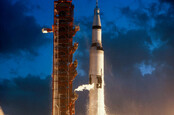This article is more than 1 year old
50 years ago, someone decided it would be OK to fire Apollo 12 through a rain cloud. Awks, or just 'SCE to Aux'?
Rule 1-404: Thou shalt not launch if the weather is crap
Part 1 It is half a century since NASA's second crack at landing a crew on the Moon had a shocking encounter on the way to orbit.
It was almost as if NASA bigwigs were looking for some way to inject a bit of drama into Apollo as the US taxpayer tired of the agency's costly jaunts off-planet.
A jolly trio (when compared the Apollo 11 crew) of Commander Charles "Pete" Conrad, Command Module Pilot Dick Gordon and Lunar Module Pilot Alan Bean was crowbarred into the Command and Service Module (CSM) "Yankee Clipper" on 14 November 1969.
Things had not proceeded entirely smoothly ahead of the launch. A leak in the CSM's LH2 tank meant it had to be swapped out and an unscheduled hold added to retank the cryogenics.

'That roar is terrific... look at that rocket go!' It's been 52 years since first Saturn V left the pad
READ MOREFortunately (or unfortunately, depending how you look at it), there was sufficient slack in the scheduled holds to avoid a launch delay, and Gemini veterans Conrad and Gordon and rookie Bean were set for an on-schedule launch 16:22 UTC... just as a cold front was creeping southward over Florida, bringing with it rain and stratocumulus clouds that covered the launchpad.
Bean should not have been there. He had missed out on Gemini and not been selected for Apollo. Instead, he was part of the follow-on Apollo Applications Program, which would go on to become Skylab. However, the tragic death of fellow Group 3 astronaut Clifton Curtis Williams meant a position on the crew had opened up, and Conrad put in a request for Bean.
The launch, from Kennedy Space Center's Pad 39A, had a launch window lasting for just over three hours, and the Saturn V left the pad on schedule. Everything appeared to be going swimmingly. That is: for the first 30 seconds or so.
Shortly after the monster rocket rolled from a launch pad azimuth of 90° to a flight azimuth of 72.029°, a "massive electrical disturbance" was reported. The crew told controllers that they reckoned the rocket had been struck by lightning, with a second strike noted at the 52-second mark.
With typical understatement, NASA's report said: "Numerous indicator lamps were illuminated at this time."
Pretty much every warning indicator lit up in the cockpit as all three fuel cells were tripped offline as well as the "8-ball" attitude indicator. All A/C power in the spacecraft was lost.
The Saturn V, however, with its independent Instrumentation Unit, kept on running as normal, oblivious to the mayhem going on in the CSM perched at its top.
Faced with garbled telemetry at Mission Control and a dying CSM, Conrad would have been forgiven for pulling the abort handle. However, Electrical, Environmental and Consumables Manager (EECOM) John Aaron had encountered a similar problem in a previous test and made the now famous call to the Flight Director: "Try SCE to Aux".
SCE was the Signalling Conditioning Electronics, which dealt with the raw signals from the instrumentation and converted them to something that could be displayed within the spacecraft and also encoded for telemetry. "Aux" would switch the SCE to a backup power supply.
While Conrad didn't immediately recognise the command, Lunar Module Pilot Bean, who was in the right-hand seat, did and flipped the switch. Bean then put the fuel cells back on line and the mission proceeded as planned.
The S-IC stage shut down at the 2:41.74 mark, and the S-II was done by 9:12.34. The first S-IVB firing was complete by 11:33.91 and Apollo 12 was left safely in Earth orbit. The crew carefully checked out the systems of their spacecraft before the S-IVB was ignited again to send the stack to the Moon.
Some fretted about the effect the lightning could have had on the explosive bolts used to release the command module's parachutes, but there was no way a rescue mission could have been launched in time, and clambering out of the CSM to take a look on the off-chance that any damage might be visible carried its own problems.
So the crew, officially oblivious of the worries, were sent on their way.
And Rule 1-404? "The vehicle will not be launched when its flight path will carry it through a cumulonimbus (thunderstorm) cloud formation." Not violated, because the lightning had been self-induced and the Saturn V had not flown through cumulonimbus clouds. ®
